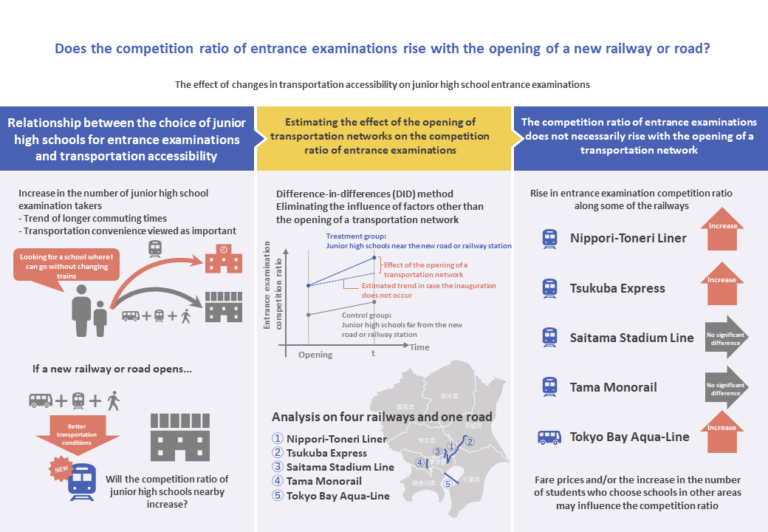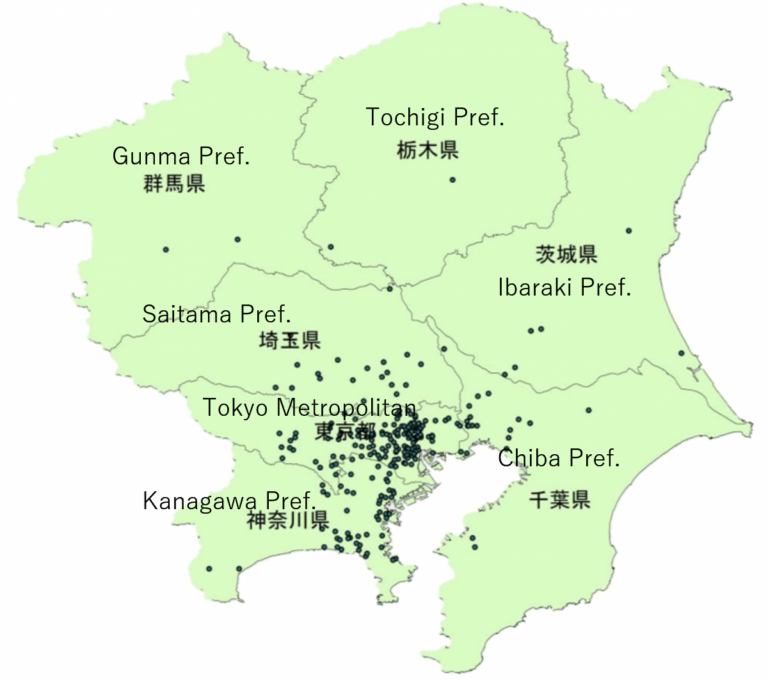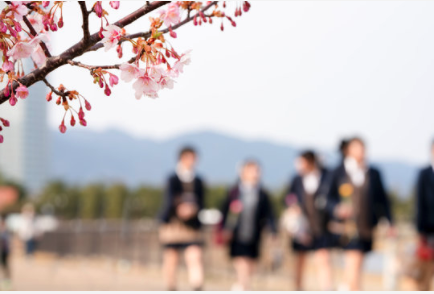Abstract

Background and issues
The number of applicants for admission to junior high schools in the Tokyo metropolitan area has gradually increased in recent years. Even though the number of students in the 6th grade of elementary schools was decreasing, the proportion of applicants to junior high schools among 6th grade elementary school students has risen to approximately 16%, indicating increased attention to junior high school examinations.
It has been reported in sources such as magazines specializing in entrance examinations that some of those children who take junior high school entrance examinations have to travel long distances to junior high schools, enduring longer and longer commuting times. In a poll conducted among parents and guardians about the matters viewed as the most important when choosing schools, about 70% of respondents considered ‘commuting conditions’ as the second most important matter, after university acceptance rates.
In view of that, in the present research we clarify the effect of changes in transportation accessibility on the choice of junior high schools for entrance examinations. We do this by means of a quantitative analysis of the effect of the opening of railways and roads on the competition ratio of schools located in the neighborhood of such lines.
As the number of applicants to junior high schools located along newly opened railway lines tends to increase, we conduct a demonstrative research based on the hypothesis that competition ratios of schools located in the neighborhood of newly opened railway lines or roads will increase, due to changes in transportation accessibility and the improved convenience resulting from the opening of such railways and roads.
No research based on examples in Japan has been reported so far that quantitatively evaluated the effect on the choice of schools of the expansion of the commuting zone resulting from the development of the transportation network.
Data analysis
The schools chosen as the subject of the present research are located in Tokyo Metropolis and six surrounding prefectures (Tokyo, Chiba, Saitama, Kanagawa, Ibaraki, Tochigi, and Gunma), for two reasons: the existence of a full transportation network infrastructure and a competitive entrance examination environment; and the availability of past data. Within that context, we restricted our analysis target to private junior high schools with no commuting area limitations (Figure 1).

Schools that were established in or that were relocated to the area after the opening of the new railway or road were excluded, because they did not fit the purpose of the present research: analyzing the change in competition ratio observed upon the opening of the transportation network. We also excluded schools that had periods when no students were recruited.
The transportation networks included in the present analysis were the following four railway lines: Tama Monorail, Saitama Stadium Line, Tsukuba Express, and Nippori-Toneri Liner; plus the Tokyo Bay Aqua-Line expressway. We estimated the influence on the competition ratios of entrance examinations to private junior high schools by the opening of those lines. The competition ratio is defined here as the number of applicants who actually took the examination divided by the number of approved applicants, excluding those students who applied to take the examination but did not do so.
In order to carry out the analysis of the present research, we built panel datasets for the schools. Data were available for 209 schools in the period from 1995 to 2019, and those were the schools included in the analysis.
To prepare the data, the Junior High School Entrance Examination Guide for the Metropolitan Area, published every year by the School Guide Editorial Department of Shobunsha, was used to collect 1995–2019 data on each school. This included the number of applicants, number of accepted students, tuition (the total amount, including enrollment fee, facilities costs for the first year, tuition fee, and other costs), the examinations schedule, adjusted standard deviation score, and other attributes such as it being a boys’ or girls’ or mixed school.
Data were also collected on the nearest train station and the railway lines that can be accessed with no transfer from that station.
Analysis method
In the present research, analysis was undertaken using the difference-in-differences (DID) method because panel data were available. Using the DID method, it is possible to eliminate unmeasurable factors other than the effect of the opening of railways or roads, such as population, or trends related to junior high school entrance examinations.
For the analysis, it is necessary to perform a classification into a treatment group which is exposed to the effects of the new railway or road, and a control group, which is not. In view of that, we performed a classification of schools for each railway and road by defining a treatment group, which includes schools for which the nearest station is one belonging to the newly opened line or to a line that permits a transfer to it, requiring up to 30 minutes to reach the line under analysis, and a control group, which includes all other schools.
Regarding the Tokyo Bay Aqua-Line, considering that most of the expressway bus lines that opened soon after the opening of the Aqua-Line in 1997 connect Kawasaki and Kisarazu, in the present analysis we included in the treatment group the schools whose nearest stations are located on the Nambu, Keihin-Tohoku, or Tokaido Line, which serve Kawasaki Station, or on the Uchibo Line, which serves Kisarazu Station, requiring up to 30 minutes to reach either Kawasaki or Kisarazu station. All other schools were included in the control group. For schools located in areas such as the Tokyo metropolitan area, where multiple stations can be considered to be nearby, we included up to three stations that were the shortest distance from the school.
In addition, for schools in suburban areas that provide transportation by school bus, we did not restrict the maximum number of nearby stations. All the stations served by the school bus were considered to be ‘the nearest’.
Using DID analysis, we quantitatively evaluated the effect of the opening of transportation facilities on the competition ratio of entrance examinations, defining the competition ratio as the explained variable, with explaining variables consisting of cross-terms of transportation and year dummies.
Evaluation and demonstration
For two lines, Nippori Toneri Liner and Tsukuba Express, a positive significance level of 1% was found for the competition ratio of entrance examinations. This indicates that the opening of a railway line resulted in higher application ratios for schools located along those lines. Likewise, a 1% positive significance result was obtained for the number of applicants as well. The opening of a railway supposedly resulted in a larger number of students who chose schools located along the lines where transportation convenience improved.
On the other hand, no significant result was obtained for the competition ratio of entrance examinations in the case of Tama Monorail and Saitama Stadium Line.
The Tama Monorail is an effective means of transportation that crosses the Tama Region in the north–south direction, while the private railway network extends only in the east–west direction. On the other hand, users have made comments such as, “Fares are high for the distance traveled” and “The prices of commuter passes for students must be reduced.” A possible reason for not obtaining significant results in the present analysis is that the fares on the Tama Monorail are high, making it less likely to be selected as a commuting route to and from junior high school.
The adjusted standard deviation score shows a negative significant correlation for both lines. This suggests that one of the reasons may be that the students who used to choose schools located along the local lines before the opening of Saitama Stadium Line began to have easier access to schools located in other areas due to the opening of the line, and students with higher academic abilities started to prefer schools in such other areas, causing the adjusted standard deviation score of schools along the local lines to decrease.
Regarding the Tokyo Bay Aqua-Line, we learned that the application ratio along the Aqua-Line expressway has increased since its opening. Moreover, an analysis considering the adjusted standard deviation score as the explained variable yielded a positive significant result. This suggests that the Kisarazu and Kawasaki areas experienced increased application ratios as a result of the opening of the Aqua-Line, and the fiercer competition caused the adjusted standard deviation score to increase as well.
Results and proposal
In the present research, with the objective of clarifying the effect of changes in transportation accessibility on the choice of schools for entrance examination applications, we conducted an investigation targeted on private junior high schools located in the Tokyo metropolitan area for which data were available.
To prepare data sets, we collected data on the number of applicants, number of accepted students, examination schedules, and other attributes from the Junior High School Entrance Examination Guide for the Metropolitan Area, published every year by the School Guide Editorial Department of Shobunsha.
In order to measure the change in the competition ratio of entrance examinations for schools located along four railway lines opened over a period of 25 years and Tokyo Bay Aqua-Line, before and after opening, we conducted analysis using the DID method to clarify the effect of the opening of those transportation facilities on the competition ratio of schools located along such lines.
As a result, it was verified that for Tsukuba Express, Nippori Toneri Liner, and Tokyo Bay Aqua-Line, there was a rise in the competition ratio of entrance examinations due to the opening of the railway line or expressway.
However, no significant result was observed in other transportation networks. It was found that depending on factors such as the price of commuting fares or the environment of schools located along the lines, the opening of a transportation network facility does not necessarily result in a higher competition ratio.


